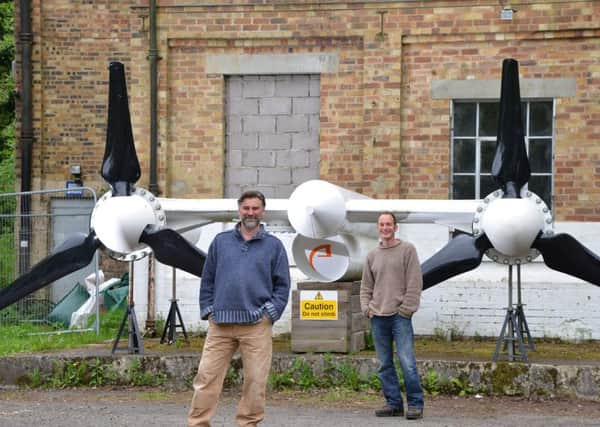New tidal turbines in Forth set to revolutionise energy sector


The unique tidal stream turbine is the brainchild of two Scottish engineers who believe it can offer an affordable and efficient way of harnessing the power of the sea to provide reliable renewable energy.
Dr David Anderson and Dr Charlie Silverton, co-founders of Roslin-based firm Renewable Devices, say their Capricorn marine turbine can outperform offshore wind schemes with respect to the cost per unit of electricity as well as ease of installation and maintenance.
Advertisement
Hide AdAdvertisement
Hide AdThe pair have invested around £250,000 over the past two of years to develop the Capricorn prototype, which looks more like a spacecraft from Star Wars than something you would expect find at the bottom of the sea.
All components have been tested separately as the project has evolved, but the completed module will be trialled in the sea for the first time when it is launched at a secret location in the Firth of Forth this week. It will be towed out into the estuary by boat, then carefully sunk underwater and tethered to float about 3m off the seabed.
The 7m-wide Capricorn 5 has twin rotors, plus a double-chambered central hull that is responsible for buoyancy. It will remain in the water for a week or so to allow its performance to be monitored.
If all goes well and no major problems are identified, the full-scale Capricorn 125 can be rolled out for commercial use within 18 months. Measuring a massive 38m across, it will be capable of producing 1.25 megawatts of electricity – enough to power around 1,000 homes.
Once commercially deployed, it is envisaged that arrays of 25 to 30 of the devices could be used to create “tide” farms.
Anderson, a mechanical engineer, says the Capricorn has been designed to cut out as much of the complicated and costly technology used in other marine devices as possible.
“Capricorn has been on the drawing board for about six years, but we’ve really only begun development in the past two-and-a-half years,” he said.
“There is a lot of expense built into the industry – from the design to deployment and everything else. Ultimately this is reflected in that people buying the electricity at the end of the chain pay more.
Advertisement
Hide AdAdvertisement
Hide Ad“What we’re trying to do is make marine technology accessible and reduce the cost of power, keeping the price per megawatt hour as low as possible.
“We’ve simplified the design quite a lot, taking out some of the very expensive technology such as yaw and pitch mechanisms, which are not well developed for tidal stream turbines, are costly and break.
“We have the small 200-kilowatt device ready to go, and it’s being launched now for the first time in its entirety.
“We’ve tested all the systems independently, some in the water, some in the laboratory, but this is the first time we’ve put the whole machine together and are putting it in the sea.
“We’ll bring it in and refine the design before putting the unit out permanently.”
Scotland is considered a world leader in marine energy, with the European Marine Energy Centre in Orkney piloting new technology from around the globe.
Industry leaders have welcomed the forthcoming launch.
Lindsay Roberts, senior policy manager at Scottish Renewables, said: “Offshore renewable energy holds huge potential for sustainable development in Scotland.
“The country is already home to some of the most advanced wave and tidal technologies, as well as the European Marine Energy Centre – arguably the most advanced marine energy proving site in the world.
“Continued innovation is key to reduce costs and improve reliability, so we wish the Capricorn device all the best.”